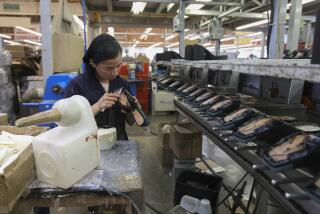Trade Gap Hits 3-Year Low as Exports Jump : Dramatic Surge in Manufactured Goods Sold Abroad Stirs Concerns Over Higher Inflation
WASHINGTON — The nation’s merchandise trade deficit fell sharply in March to $9.7 billion, the lowest level in three years, as exports soared to an all-time high and import growth moderated, the Commerce Department reported Tuesday.
The March trade deficit was fully $4.1 billion lower than February’s. Exports soared by $5.4 billion to $29 billion.
Administration officials hailed the jump in exports as further evidence that the economy was being driven by a boom in manufactured goods sold abroad. They said that should ease protectionist pressures in Congress and diminish trade as an election issue this fall.
Higher Interest Rates
But private economists saw the dramatic surge in exports as a further indicator of labor and supply shortages, higher inflation and higher interest rates.
Investors seemed to agree, and markets that fell a month ago when the trade deficit was reported as rising slumped again on the news that the trade picture had brightened. Stock and bond rallies fizzled early, with the Dow Jones industrial average closing down 21.22 points.
“Markets are so fearful of inflation now it’s going to take a lot more than one month of better trade numbers to make them feel better,” said Jay Goldinger, an international exchange and bond specialist with Capital Insight, a Los Angeles investment firm.
President Reagan, addressing reporters at the White House, called the March trade figures “the best news on this front since March of 1985.” Suggesting that he would soon veto the trade bill that Congress approved late last month, he said: “This is not the time to be imposing restrictions on trade or reducing incentives for free, open markets.”
Commerce Secretary C. William Verity Jr. said in a statement that the latest report demonstrates the “decisive improvement in the trade balance that is now under way.”
Part of the latest improvement stemmed from temporary factors, including a $600-million sale of gold bullion to Taiwan and a $600-million decline in oil imports, reflecting lower prices as well as smaller volumes.
But most of the improvement resulted from a broad-based jump in exports of a range of products, primarily in manufactured goods such as machinery, telecommunications and computer equipment and aircraft.
These products have steadily grown more competitive in foreign markets as the dollar has fallen in value, thus making American goods cheaper for foreigners to buy, and as U.S. manufacturing productivity has spurted.
Volatility Cited
“It’s almost as good as it looks,” said Jeannette Garretty, a senior vice president at Bank of America in San Francisco. “A good bit of it is in gold shipments, which don’t count toward economic growth, and there is always volatility in trade figures from month to month. But this is for real in that it confirms that we are looking at export growth in manufacturing, in California and nationwide.”
In part, Garretty said, the trade deficit is subject to wide monthly swings because reporting of imports and exports is imprecise.
More than that, relatively small changes in total monthly imports and exports can spell a much larger percentage change in the trade deficit, which is the difference between them. In March, for example, imports rose by 4% and exports by 23%, but the deficit fell by 30%.
First Improvement in Years
The trade deficit swings less widely over three-month periods. And the totals for the three months ending in March marked the first clear-cut quarterly trade balance improvement in years.
The deficit for the first three months of this year was $36 billion, compared to $39.2 billion in the first three months of 1987 and $38 billion in the first quarter of 1986. The last time a monthly deficit was this low was in March, 1985, when the imports exceeded exports by about $8 billion.
Some economists were alarmed by March’s 4% increase in imports, to $38.7 billion.
“Because we have a strong economy driven by manufactured exports,” Garretty said, “we are importing machinery and capital goods because demand in our growing industrial sector is still outrunning domestic supply, and we are importing the difference.”
Factory Utilization Up
Indeed, in a separate report Tuesday, the government said that factory utilization moved up again to 82.7% of industrial capacity, the highest level in eight years. Two weeks ago, unemployment fell to 5.4%, the lowest level in 14 years. Most economists believe that higher inflation cannot be far behind.
“Trade is no longer the measure that drives markets,” said David Levine of Sanford C. Bernstein & Co. in New York. If the trade deficit disappeared in the next year, he said, stock prices would fall and bond prices would tumble for fear of inflation.
From a purely economic standpoint, Jerry L. Jordan, a senior vice president at First Interstate Bank in Los Angeles, took satisfaction from the increases in both imports and exports.
“The import increases were industrial equipment and capital goods, which reflects investment by our industries,” he said. “The export increases were in aircraft, computers and other higher-technology goods, which ought to be our strength.”
U.S. TRADE DEFICIT * Monthly totals for 1985 and 1986 do not reflect the corrected measure of U.S. exports to Canada. In 1986 the annual undercover of exports, before the Canadian measure of imports from the U.S., was an average of $850 million per month; in 1985 the undercount averaged %500 million per month. But monthly figures are not available. Source: Commerce Department
More to Read
Inside the business of entertainment
The Wide Shot brings you news, analysis and insights on everything from streaming wars to production — and what it all means for the future.
You may occasionally receive promotional content from the Los Angeles Times.










